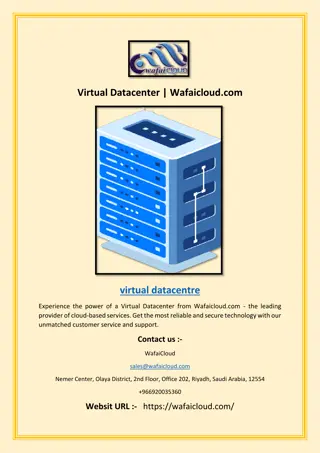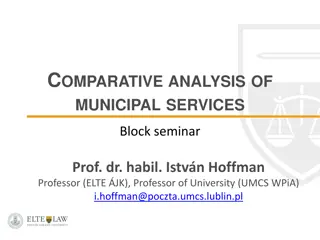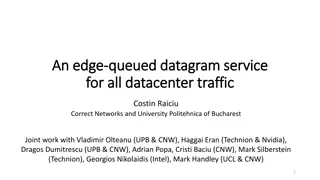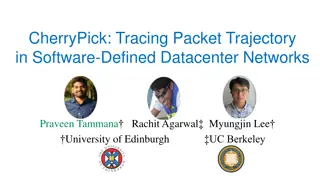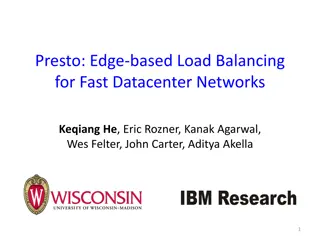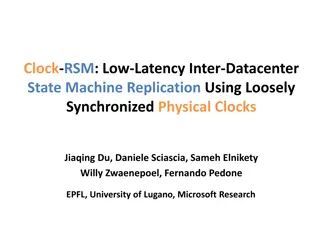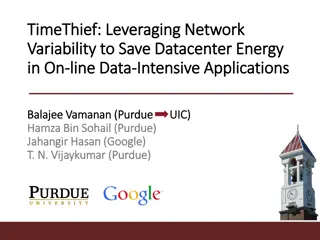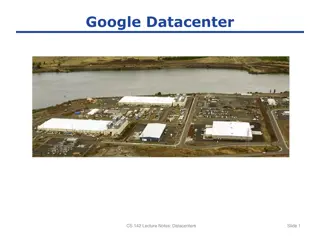
Inside the Data Center: Understanding Cloud Computing Infrastructure
Explore the inner workings of data centers in cloud computing, from traffic routing to tiered services. Learn about caching, lightweight services, and the relationship between frontend and backend systems. Discover how services like Memcached, BigTable, and MapReduce play crucial roles in cloud infrastructure.
Download Presentation

Please find below an Image/Link to download the presentation.
The content on the website is provided AS IS for your information and personal use only. It may not be sold, licensed, or shared on other websites without obtaining consent from the author. If you encounter any issues during the download, it is possible that the publisher has removed the file from their server.
You are allowed to download the files provided on this website for personal or commercial use, subject to the condition that they are used lawfully. All files are the property of their respective owners.
The content on the website is provided AS IS for your information and personal use only. It may not be sold, licensed, or shared on other websites without obtaining consent from the author.
E N D
Presentation Transcript
CS5412 Spring 2014 (Cloud Computing: Birman) 1 CS5412: DIVING IN: INSIDE THE DATA CENTER Lecture V Ken Birman
Data centers 2 Once traffic reaches a data center it tunnels in First passes through a filter that blocks attacks Next, a router that directs it to a tier one computer (one of many) hosting the proper services Each hosted company has its own domain but also runs inside a kind of virtual enterprise: looks like a private network, with its own IP addresses etc. These can make use of shared services provided by the cloud provider, like file system services CS5412 Spring 2014 (Cloud Computing: Birman)
Tier two and Inner Tiers 3 If tier one faces the user and constructs responses, what lives in tier two? Caching services are very common (many flavors) Other kinds of rapidly responsive lightweight services that are massively scaled Inner tier services might still have online roles, but tend to live on smaller numbers of nodes: maybe tens rather than hundreds or thousands CS5412 Spring 2014 (Cloud Computing: Birman)
Tier two and Inner Tiers 4 Tiers one and two soak up the load This reduces load on the inner tiers, and in fact there may be further layers of caching to soak up load outside the data center (Akamai, Facebook edge, etc.) Many services use asynchronous streams of updates Send updates down towards inner services but don t wait and don t hold locks! Notifications percolate up, often showing up much later. Meanwhile, tier one runs with potentially out-of-data cached data. Tier 1 Service Tier 1 Service Tier 1 ServiceTier 1 Tier 1 Service Service Backend DB CS5412 Spring 2014 (Cloud Computing: Birman)
Contrast with Back office 5 A term often used for services and systems that don t play online roles In some sense the whole cloud has an outward facing side, handling users in real-time, and an inward side, doing offline tasks Still can have immense numbers of nodes involved but the programming model has more of a batch feel to it For example, MapReduce (Hadoop) CS5412 Spring 2014 (Cloud Computing: Birman)
Some interesting services well consider 6 Memcached: In-memory caching subsystem Dynamo: Amazon s shopping cart BigTable: A sparse table for structured data GFS: Google File System Chubby: Google s locking service Zookeeper: File system with locking, strong semantics Sinfonia: A flexible append-only logging service MapReduce: Functional computing for big datasets CS5412 Spring 2014 (Cloud Computing: Birman)
Connection to DHT concept 7 Last time we focused on a P2P style of DHT These services are mostly built as layers over a data center DHT deployment Same idea and similar low-level functionality But inside the data center we can avoid costly indirect routing. We ll discuss that next time. CS5412 Spring 2014 (Cloud Computing: Birman)
Memcached 8 Very simple concept: High performance distributed in-memory caching service that manages objects Key-value API has become an accepted standard Many implementations Simplest versions: just a library that manages a list or a dictionary Fanciest versions: distributed services implemented using a cluster of machines CS5412 Spring 2014 (Cloud Computing: Birman)
Memcached API 9 Memcached defines a standard API Defines the calls the application can issue to the library or the server (either way, it looks like library) In theory, this means an application can be coded and tested using one version of memcached, then migrated to a different one function get_foo(foo_id) foo = memcached_get("foo:" . foo_id) if foo != null return foo foo = fetch_foo_from_database(foo_id) memcached_set("foo:" . foo_id, foo) return foo end CS5412 Spring 2014 (Cloud Computing: Birman)
A single memcached server is easy 10 Today s tools make it trivial to build a server Build a program Designate some of its methods as ones that expose service APIs Tools will create stubs: library procedures that automate binding to the service Now run your service at a suitable place and register it in the local registry Applications can do remote procedure calls, and these code paths are heavily optimized: quite fast CS5412 Spring 2014 (Cloud Computing: Birman)
Can one use a cluster to host a scalable version of Memcached? 11 Much trickier challenge! Trivial approach just hashes the memcached key to decide which server to send data to But this could lead to load imbalances, plus some objects are probably popular, while others are probably cold spots . Would prefer to replicate the hot data to improve capacity But this means we need to track popularity (like Beehive!) Solutions to this are being offered as products We have it as one of the possible cs5412 projects! CS5412 Spring 2014 (Cloud Computing: Birman)
Dynamo 12 Amazon s massive collaborative key-value store Built over a version of Chord DHT Basic idea is to offer a key-value API, like memcached But now we ll have thousands of service instances Used for shopping cart: a very high-load application Basic innovation? To speed things up (think BASE), Dynamo sometimes puts data at the wrong place Idea is that if the right nodes can t be reached, put the data somewhere in the DHT, then allow repair mechanisms to migrate the information to the right place asynchronously CS5412 Spring 2014 (Cloud Computing: Birman)
Dynamo in practice 13 Suppose key should map to N56 Dynamo replicates data on neighboring nodes (N1 here) Will also save key,value on subsequent nodes if targets don t respond Data migrates to correct location eventually CS5412 Spring 2014 (Cloud Computing: Birman)
Dynamo in practice 14 When Amazon rolled Dynamo out, there was a huge need for scalable key-value storage, and Dynamo responded to this (e.g. shopping cart) But in fact it wasn t popular with people more familiar with database APIs Eventually Amazon introduced Dynamo-DB which has a NoSQL API: SQL but with weak consistency. This has been far more successful for many uses. CS5412 Spring 2014 (Cloud Computing: Birman)
Lessons learned? 15 Notice that we started with Chord: a DHT for big P2P uses. But nobody has big P2P systems! Dynamo was initially just Chord adapted for use inside a data-center, as a service, adjusted to deal with the peculiar failure patterns seen at Amazon. But ultimately, with Dynamo-DB, Amazon was forced to change the model to bridge to developers. CS5412 Spring 2014 (Cloud Computing: Birman)
BigTable 16 Yet another key-value store! Built by Google over their GFS file system and Chubby lock service Idea is to create a flexible kind of table that can be expanded as needed dynamically Like Dynamo-DB, starts with a DHT idea but then grew to become a specialized solution with many features CS5412 Spring 2014 (Cloud Computing: Birman)
Data model: a big map <Row, Column, Timestamp> triple for key Arbitrary columns on a row-by-row basis Column family:qualifier. Family is heavyweight, qualifier lightweight Column-oriented physical store- rows are sparse! Does not support a relational model No table-wide integrity constraints No multirow transactions CS5412 Spring 2014 (Cloud Computing: Birman) 17
API 18 Metadata operations Create/delete tables, column families, change metadata Writes (atomic) Set(): write cells in a row DeleteCells(): delete cells in a row DeleteRow(): delete all cells in a row Reads Scanner: read arbitrary cells in a bigtable Each row read is atomic Can restrict returned rows to a particular range Can ask for just data from 1 row, all rows, etc. Can ask for all columns, just certain column families, or specific columns CS5412 Spring 2014 (Cloud Computing: Birman)
Versions 19 Data has associated version numbers To perform a transaction, create a set of pages all using some new version number Then can atomically install them For reads can let BigTable select the version or can tell it which one to access CS5412 Spring 2014 (Cloud Computing: Birman)
SSTable Immutable, sorted file of key-value pairs Chunks of data plus an index Index is of block ranges, not values SSTable 64K block 64K block 64K block Index CS5412 Spring 2014 (Cloud Computing: Birman) 20
Tablet Contains some range of rows of the table Built out of multiple SSTables Start:aardvark End:apple Tablet SSTable SSTable 64K block 64K block 64K block 64K block 64K block 64K block Index Index CS5412 Spring 2014 (Cloud Computing: Birman) 21
Table Multiple tablets make up the table SSTables can be shared Tablets do not overlap, SSTables can overlap Tablet Tablet apple boat aardvark apple_two_E SSTable SSTable SSTable SSTable CS5412 Spring 2014 (Cloud Computing: Birman) 22
Finding a tablet Stores: Key: table id + end row, Data: location Cached at clients, which may detect data to be incorrect in which case, lookup on hierarchy performed Also prefetched (for range queries) CS5412 Spring 2014 (Cloud Computing: Birman) 23
Servers Tablet servers manage tablets, multiple tablets per server. Each tablet is 100-200 MB Each tablet lives at only one server Tablet server splits tablets that get too big Master responsible for load balancing and fault tolerance CS5412 Spring 2014 (Cloud Computing: Birman) 24
Masters Tasks Use Chubby to monitor health of tablet servers, restart failed servers Tablet server registers itself by getting a lock in a specific directory chubby Chubby gives lease on lock, must be renewed periodically Server loses lock if it gets disconnected Master monitors this directory to find which servers exist/are alive If server not contactable/has lost lock, master grabs lock and reassigns tablets GFS replicates data. Prefer to start tablet server on same machine that the data is already at CS5412 Spring 2014 (Cloud Computing: Birman) 25
Masters Tasks (Cont) When (new) master starts grabs master lock on chubby Ensures only one master at a time Finds live servers (scan chubby directory) Communicates with servers to find assigned tablets Scans metadata table to find all tablets Keeps track of unassigned tablets, assigns them Metadata root from chubby, other metadata tablets assigned before scanning. CS5412 Spring 2014 (Cloud Computing: Birman) 26
Metadata Management Master handles table creation, and merging of tablet Tablet servers directly update metadata on tablet split, then notify master lost notification may be detected lazily by master CS5412 Spring 2014 (Cloud Computing: Birman) 27
Editing a table Mutations are logged, then applied to an in-memory memtable May contain deletion entries to handle updates Group commit on log: collect multiple updates before log flush Tablet Memtable Insert Memory Insert boat apple_two_E tablet log Delete Insert Delete SSTable SSTable GFS Insert CS5412 Spring 2014 (Cloud Computing: Birman) 28
Programming model 29 Application reads information Uses it to create a group of updates Then uses group commit to install them atomically Conflicts? One wins and the other fails , or perhaps both attempts fail But this ensures that data moves in a predictable manner version by version: a form of the ACID model! Thus BigTable offers strong consistency CS5412 Spring 2014 (Cloud Computing: Birman)
Compactions Minor compaction convert the memtable into an SSTable Reduce memory usage Reduce log traffic on restart Merging compaction Reduce number of SSTables Good place to apply policy keep only N versions Major compaction Merging compaction that results in only one SSTable No deletion records, only live data CS5412 Spring 2014 (Cloud Computing: Birman) 30
Locality Groups Group column families together into an SSTable Avoid mingling data, e.g. page contents and page metadata Can keep some groups all in memory Can compress locality groups Bloom Filters on SSTables in a locality group bitmap on keyvalue hash, used to overestimate which records exist avoid searching SSTable if bit not set Tablet movement Major compaction (with concurrent updates) Minor compaction (to catch up with updates) without any concurrent updates Load on new server without requiring any recovery action CS5412 Spring 2014 (Cloud Computing: Birman) 31
Log Handling Commit log is per server, not per tablet (why?) complicates tablet movement when server fails, tablets divided among multiple servers can cause heavy scan load by each such server optimization to avoid multiple separate scans: sort log by (table, rowname, LSN), so logs for a tablet are clustered, then distribute GFS delay spikes can mess up log write (time critical) solution: two separate logs, one active at a time can have duplicates between these two CS5412 Spring 2014 (Cloud Computing: Birman) 32
Immutability SSTables are immutable simplifies caching, sharing across GFS etc no need for concurrency control SSTables of a tablet recorded in METADATA table Garbage collection of SSTables done by master On tablet split, split tables can start off quickly on shared SSTables, splitting them lazily Only memtable has reads and updates concurrent copy on write rows, allow concurrent read/write CS5412 Spring 2014 (Cloud Computing: Birman) 33
Microbenchmarks CS5412 Spring 2014 (Cloud Computing: Birman) 34
Performance CS5412 Spring 2014 (Cloud Computing: Birman) 35
Application at Google CS5412 Spring 2014 (Cloud Computing: Birman) 36
GFS and Chubby 37 GFS file system used under the surface for storage Has a master and a set of chunk servers To access a file, ask master it directs you to some chunk server and provides a capability That server sends you the data Chubby lock server Implements locks with varying levels of durability Implemented over Paxos, a protocol we ll look at a few lectures from now CS5412 Spring 2014 (Cloud Computing: Birman)
GFS Architecture 38 CS5412 Spring 2014 (Cloud Computing: Birman)
Write Algorithm is trickier 39 1. Application originates write request. 2. GFS client translates request from (filename, data) -> (filename, chunk index), and sends it to master. 3. Master responds with chunk handle and (primary + secondary) replica locations. 4. Client pushes write data to all locations. Data is stored in chunkservers internal buffers. 5. Client sends write command to primary. CS5412 Spring 2014 (Cloud Computing: Birman)
Write Algorithm is trickier 40 6. Primary determines serial order for data instances stored in its buffer and writes the instances in that order to the chunk. 7. Primary sends serial order to the secondaries and tells them to perform the write. 8. Secondaries respond to the primary. 9. Primary responds back to client. Note: If write fails at one of chunkservers, client is informed and retries the write. CS5412 Spring 2014 (Cloud Computing: Birman)
Write Algorithm is trickier 41 CS5412 Spring 2014 (Cloud Computing: Birman)
Write Algorithm is trickier 42 CS5412 Spring 2014 (Cloud Computing: Birman)
Weve only scratched the surface 43 We ve focused on scalable storage But there are many other major, important services What are some examples? We don t have time for deep dives but can at least mention a few CS5412 Spring 2014 (Cloud Computing: Birman)
Zookeeper 44 Created at Yahoo! Integrates locking and storage into a file system Files play the role of locks Also has a way to create unique version or sequence numbers But basic API is just like a Linux file system Implemented using virtual synchrony protocols (we ll study those too, when we talk about Paxos) Extremely popular, widely used CS5412 Spring 2014 (Cloud Computing: Birman)
Sinfonia 45 Created at HP Labs Core construct: durable append-only log replicated for high availability and fast load-balanced reads Concept of a mini-transaction that appends to the state Then specialized by a series of plug-in modules Can support a file system Lock service Event notification service Message queuing system Database system Like Chubby, uses Paxos at the core CS5412 Spring 2014 (Cloud Computing: Birman)
Sinfonia 46 To assist developer in gaining more speed, application can precompute transaction using cached data At transaction execution time we check validity of the data read during precomputation Thus the transation can just do a series of writes at high speed, without delay to think CS5412 Spring 2014 (Cloud Computing: Birman)
Key idea in Sinfonia 47 A persistent, append-oriented durable log offers Strong guarantees of consistency Very effective fault-tolerance, if implemented properly A kind of version-history model We can generalize from this to implement all those other applications by using Sinfonia as a version store or a data history Seen this way, very much like the BigTable story ! CS5412 Spring 2014 (Cloud Computing: Birman)
Second idea 48 Precomputation allows us to create lots of read-only data replicas that can be used for offline computation Sometimes it can be very slow to compute a database operation, like a big join So we do this offline permitting massive speedups By validating that the data didn t change we can then apply just the updates in a very fast transaction after we ve figured out the answer Note that if we re-ran the whole computation we would get the same answers, since inputs are unchanged! CS5412 Spring 2014 (Cloud Computing: Birman)
MapReduce 49 Used for functional style of computing with massive numbers of machines and huge data sets Works in a series of stages Maptakes some operations and maps it on a set of servers so that each does some part The operations are functional: they don t modify the data they read and can be reissued if needed Result: a large number of partial results, each from running the function on some part of the data Reduce combines these partial results to obtain a smaller set of result files (perhaps just one, perhaps a few) Often iterates with further map/reduce stages CS5412 Spring 2014 (Cloud Computing: Birman)
Hadoop 50 Open source MapReduce Has many refinements and improvements Widely popular and used even at Google! Challenges Dealing with variable sets of worker nodes Computation is functional; hard to accommodate adaptive events such as changing parameter values based on rate of convergence of a computation CS5412 Spring 2014 (Cloud Computing: Birman)

